In this article, you'll have access to the following information:
I. Introduction - What is an end mill?
Choosing the right end mill before turning on your CNC machine can be a pretty complex task. Many variables come into play, such as end mill length, geometry, profile type, material, while several trade-offs have to be considered: performance, cost, surface finish, tool life,...
What is an end mill actually, is it like a drill bit? It is a usual question that comes up since terminologies are often mixed up, but the answer is no. A drill bit is designed to plunge directly into the material and create holes only, while an end mill can cut laterally into the material and create slots or profiles. Besides, most end mills are designed to be centre-cutting, meaning they can plunge into the material as well and making them far more versatile than drill bits.
This article aims at explaining the basics of end mill science while answering the simple question you might have: which end mill should I use on my CNC machine?
Three major factors will influence your choice :
- What kind of shapes do you want to mill (2D contour, 3D shape, holes,...)?
- What kind of material do you want to mill?
- What are your goals in terms of performance and surface finish, while keeping an acceptable cost for you and staying within the capabilities of your CNC machine?
Answering these questions will help you determine the desired tool geometry, based on your project type, the material being cut and on the desired surface finish. So let’s dive into the theory and answer those questions later with some concrete examples.
II. Key characteristics of an end mill
The main features used to describe an end mill are illustrated below.

On top of these geometric features, end mills are characterised by their type, number of flutes, material (and coating). Thus, in a classical catalogue, the end mill above would be described as:
- Type: flat end
- Number of flutes: 4
- Material: solid carbide
- Shank diameter: 6mm
- Cutter diameter: 6mm
- Overall length: 50mm
- Flute length: 22mm
- Helix angle: 45°
Each of these features has a direct influence on how the end mill will behave during a machining operation and on the cutting possibilities in terms of performance and shapes.
What size of end mill should I use?
Imagine you want to mill a very deep pocket inside a high part. You will need a long tool to be able to machine the bottom without colliding your spindle mandrel with the stock of the material. Hence, the length of your end mill will be determined by how deep it must penetrate into the material. The associated concept with this observation is called “stickout”. It is defined by the distance from the end of the tool holder to the tip of the end mill.
Also, keep in mind that the cutting depth should never exceed the flute length of your end mill. If cutting deeper than the length of the flutes, chips won’t clear properly, heat will build up and you risk to damage your tool.
At this point, it might seem smart to buy end mills that are as long as possible to have the flexibility to use them in more situations, right? It’s actually not the case, because the more stickout, the less rigid a tool is. If it sticks out too far and you work it too demanding, the cutting forces will make it bend, which is what is called “tool deflection.”
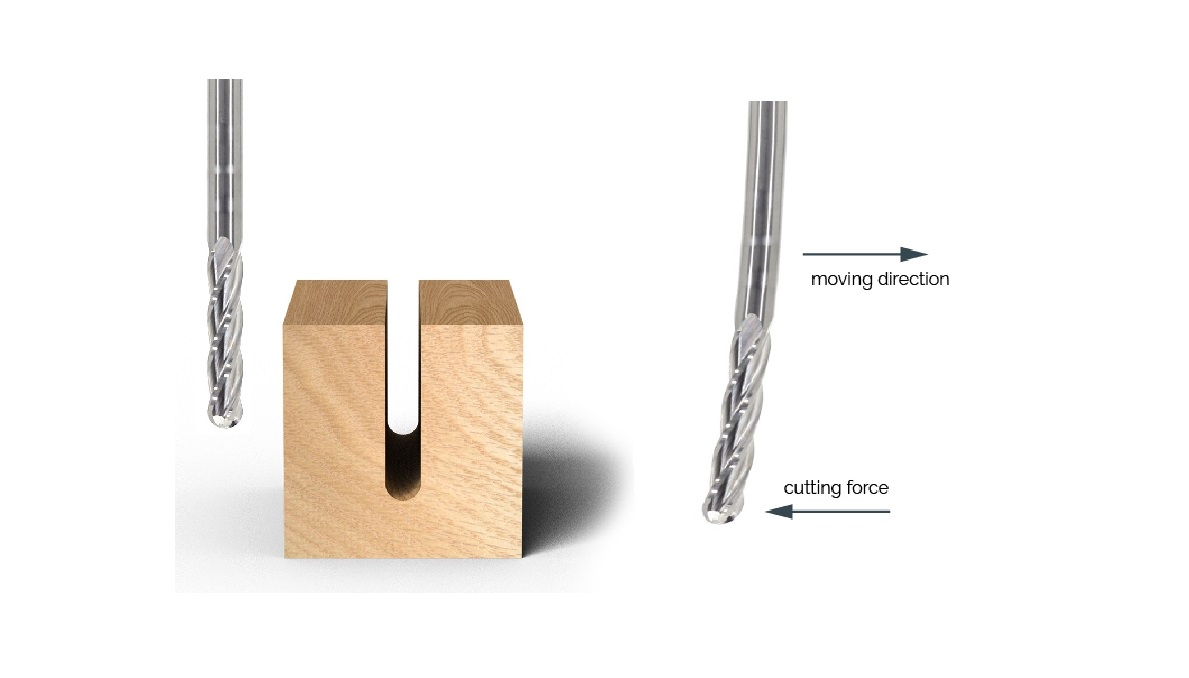
Tool deflection can actually be very problematic since it induces:
- chatter, which are vibrations caused by the relative movement between the workpiece and the cutting tool;
- bad surface finish with ripples, mostly induced by the chatter;
- inaccurate tolerances on the machined part;
- reduced tool life resulting from bending fatigue.
In short, shorter end mills are more rigid and less expensive. So save the extra-long ones for operations where they are really needed
Shank & cutter diameter
The diameter of your tool will have a direct incidence on the profiles you can cut. Let’s say you want to make a box and assemble it using 90° interlocking joints.
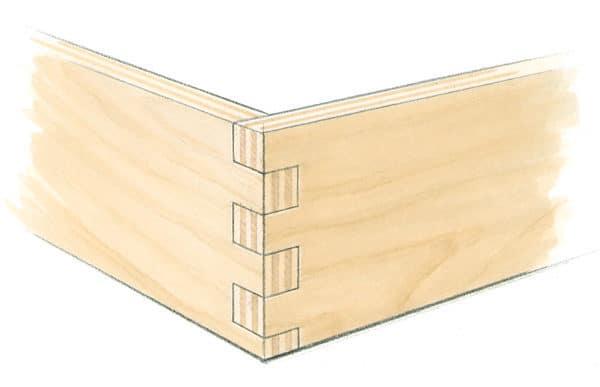 Since your tool is a cylinder with a certain radius, it won’t be possible to do it as such. Indeed, the tool will leave a circular profile in every internal corner, with a radius equal to half its diameter. The larger your end mill diameter, the bigger the radius of this circular profile. In order to overcome this problem, CNC operators use what is called “dogbones”. Dog bone corners describe the shape of a corner that is extended outside the cut area to create a perfect 90º corner.
Since your tool is a cylinder with a certain radius, it won’t be possible to do it as such. Indeed, the tool will leave a circular profile in every internal corner, with a radius equal to half its diameter. The larger your end mill diameter, the bigger the radius of this circular profile. In order to overcome this problem, CNC operators use what is called “dogbones”. Dog bone corners describe the shape of a corner that is extended outside the cut area to create a perfect 90º corner.
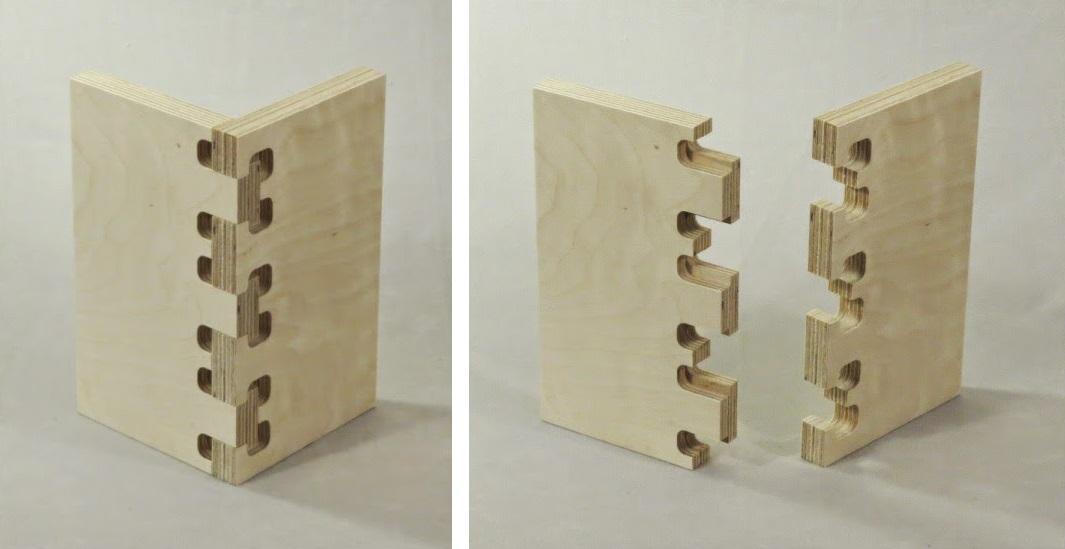
On the other hand, increasing the diameter of your tool offer two main advantages.
First, it makes your tool more rigid, which will allow you to make deeper cuts while minimizing tool deflection. A lot more rigid actually, since increasing diameter by 2x will increase its rigidity by a factor of 16x.
Secondly, it improves your MMR (Material Removal Rate) since the end mill can remove more material per unit of time when it is moving inside the material, allowing you to optimise certain operations and do the same job faster.
How many flutes should I choose?
Flutes are the deep spiral grooves that allow chip formation and evacuation. They are the part of the end mill anatomy that create those sharp cutting edges (sometimes referred to as “teeth”).

The number of flutes on your end mill is a crucial parameter that depends mostly on the material you want to cut and on the capabilities of your machine. Indeed, the number of flutes on your end mill will impact:
- the feed rate of your machine,
- the surface finish of your piece, and
- the ability of the tool to clear chips.
Feed rate is indeed directly linked to the number of flutes of your end mill: if you add flutes, you will have to increase the feed rate, or decrease the rotational speed of your spindle, to keep a constant chip load. So depending on the speed capabilities of your CNC machine and of your spindle, you might have to choose an end mill with less/more flutes.
If you are not familiar with those concepts, we recommend you to have a look at our article on feeds and speeds.
Secondly, having more flutes on a tool creates smoother cuts, but it also leaves less space for chips to evacuate. This can be somehow overlooked if you are cutting soft materials, but not at all if you are cutting aluminium for instance. The reason is that aluminium produces very large chips compared to other materials. So when the end mill is cutting down in a hole or a slot, its flutes provide a crucial path for chips to escape. That explains why it is recommended to use 2 or 3 flutes end mills with aluminium since they have more chip clearance than with a 4-flutes one, where the chips will jam progressively, overlapping the cutting edges of your tool and making it break eventually.
To sum up, fewer flutes are best at chip clearing, while more flutes create a smoother surface finish.
Should my helix angle be higher or lower?
General-purpose end mills typically have helix angles around 30°. Increasing the helix angle will reduce the cutting forces and the amount of heat and vibration generated during the milling process. Hence, end mills with a higher helix angle tend to produce a better surface finish on the workpiece.
 It comes with a trade-off, unfortunately. The end mill will be weaker and won't sustain heavy depths of cut with high feed rates. So lower helix angle cutters are stronger, but they give a less smooth surface finish.
It comes with a trade-off, unfortunately. The end mill will be weaker and won't sustain heavy depths of cut with high feed rates. So lower helix angle cutters are stronger, but they give a less smooth surface finish.
III. Different types and shapes of end mills exists
There are as many different end mill types as there are possible cutting operations: profiling, contouring, slotting, counterboring, drilling,... Here is a short overview of the main ones.
Square end mills are the most common ones and can be used for many milling applications, including slotting, profiling and plunge cutting.
Corner-radius end mills have slightly rounded corners that help distribute cutting forces evenly to prevent damage to the end mill and extend its life. They can create flat-bottomed grooves with slightly rounded inside corners.
Roughing end mills are used to quickly remove large amounts of material during heavy operations. Their design allows for little to no vibration but leaves a rougher finish.
Tapered end mills are centre-cutting tools that can be used for plunging, and are designed to machine angled slots. They are generally used in die-casts and moulds.
Ball end mills have rounded tips and are used to mill 3D shapes or rounded grooves.
T-slot end mills can easily cut accurate keyways and T-slots to create working tables or other similar applications.
Straight flutesend mills have a zero degrees helix. They work well for materials where the lifting effect of a spiral flute might cause unwanted results, such as wood, plastics and composites. For those materials, the straight flute minimizes the fraying of the edges and provides better surface finishes than helical general purpose end mills.
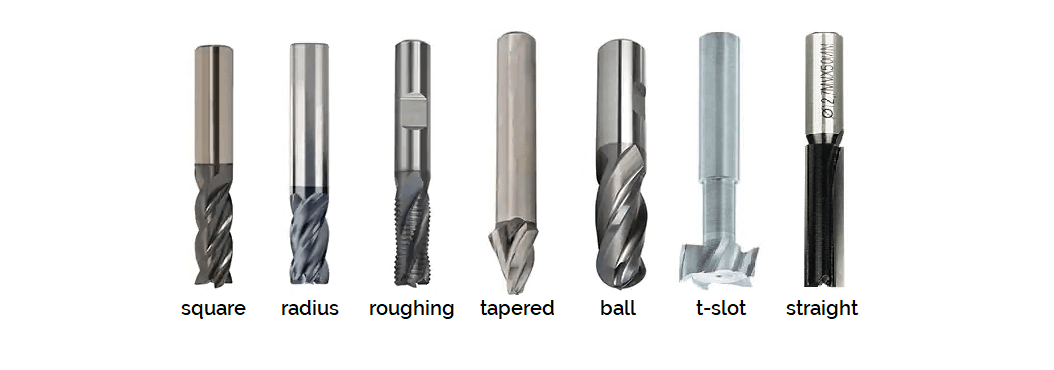
As your CNC router spins the cutter clockwise, the helical direction of the flutes determines if chips are ejected towards the top or bottom of the workpiece. Upcut end mills are the most conventional ones, pullingthe chips away from the material, which is a very important feature for most milling operations on many different materials. It has a downside if you want to cut laminated materials since it leaves a poorer surface finish on the top of the workpiece. A downcut end mill has the advantage to push chips down, leaving a cleaner cut on top, but then it will also fray the bottom edge.

Combine an upcut and a downcut and you have a compression cutter, where the flutes are carved one way for the bottom half of the flute length and the other way at the top. That feature makes them a very good candidate to cut plywood, composites, and laminates. Try to use one to cut a sheet of plywood in one pass, and you should obtain cleaner edges on both sides.
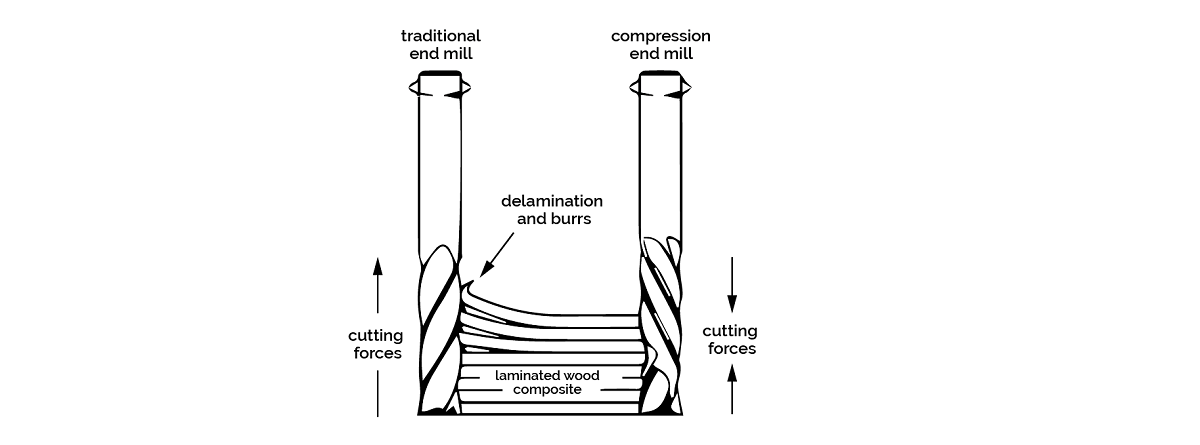
IV. How to choose the proper material for your end mill
This section could deserve an entire article, so let’s keep it concise and talk about the two main materials used to make cutting tools: HSS and carbide.
High-Speed Steel (HSS) is the least expensive of the two, it provides good wear resistance and can be used to mill many materials, such as wood, metals,...
Coated Carbide end mills are more expensive than HSS ones, but they provide better rigidity and can be run 2 to 3 times faster than HSS. They’re also extremely heat resistant, making them suitable to mill tougher materials as well.
Are carbide end mills worth the extra money then? Yes, definitely.
Since they can run way faster than HSS, they will increase your machine productivity a lot. They are also more durable and have a longer tool life, making them worth the investment.
Another easy way to increase the performances of your end mills is to add a good coating. The most common one, TiAlN (Titanium aluminium nitride), will allow you to cut 25% faster on average without spending too much money.

If you don’t care too much about performance, then choose carbide end mills that are 8mm or less in diameter. Consider HSS for larger cutters to save some money, when the tool rigidity can be compensated by its larger diameter. Besides, if you are beginning with CNC milling, don’t forget that you might make mistakes and break a few end mills before getting it right, better HSS ones as well then.
V. How to choose the proper end mill for your project
Let's answer our original questions with an example: I want to mill a small food tray.
- What kind of shapes do you want to mill?
- What kind of material do you want to mill?
- What are your goals in terms of performance and surface finish, while keeping an acceptable cost for you and staying within the capabilities of your CNC machine?
I want to make a small batch of 10 items, so I’m trying to optimize the machining time within reasonable limits.

Based on those observations, I know that I need a flat-end mill type to get a nice flat surface inside the pocket. I will go for a diameter of 8mm, quite large because I don't want to waste too much time while removing all that material and because the inside corners are already designed to be rounded. I'll use a short carbide end mill as well, like 30mm long, because oak is a hardwood and I will need the rigidity to keep a high feed rate. Since the pocket is pretty shallow and chips will evacuate easily, I will choose a 3-flutes end mill with a 45° helix angle to get the best surface finish possible and spend little time hand-finishing.
About Mekanika
Mekanika is a Belgian startup based in Brussels whose ambition is to make local production more accessible. We produce desktop machines for screen printing and CNC milling, which have been recognized for their quality and ease of use, with open source plans allowing makers to adapt their tools to their specific needs.
Visit our shop to find out more, or check out our tutorials to continue learning.